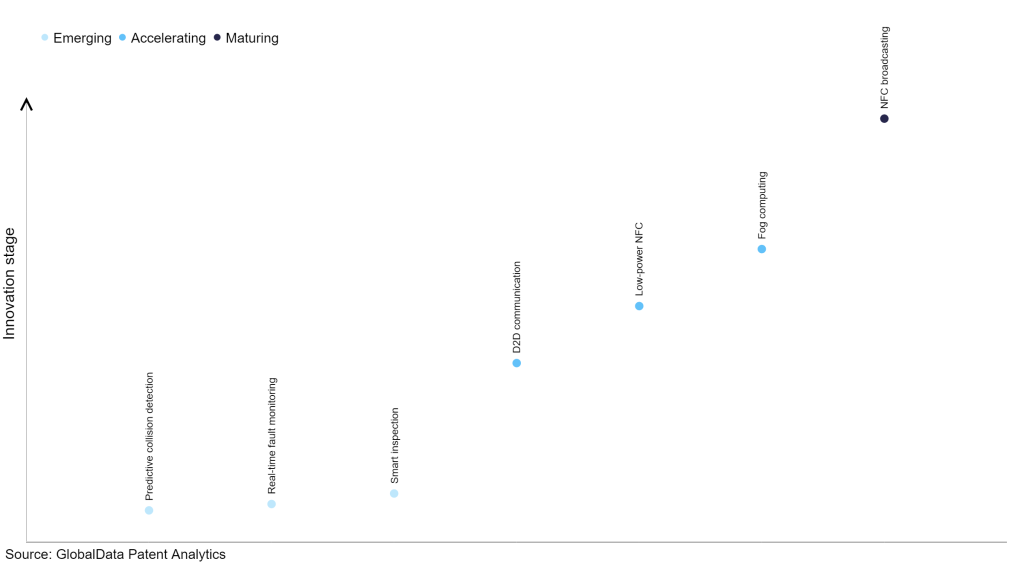The technology industry continues to be a hotbed of patent innovation. Activity is driven by the increasing volume of IoT-generated data, the need for real-time analytics, and the demand for efficient and low-latency processing at the edge, and growing importance of technologies such as edge devices, fog nodes, edge analytics, communication protocols, and data management solutions. In the last three years alone, there have been over 1.5 million patents filed and granted in the technology industry, according to GlobalData’s report on Internet of Things in technology: fog computing. Buy the report here.
However, not all innovations are equal and nor do they follow a constant upward trend. Instead, their evolution takes the form of an S-shaped curve that reflects their typical lifecycle from early emergence to accelerating adoption, before finally stabilizing and reaching maturity.
Identifying where a particular innovation is on this journey, especially those that are in the emerging and accelerating stages, is essential for understanding their current level of adoption and the likely future trajectory and impact they will have.
185+ innovations will shape the technology industry
According to GlobalData’s Technology Foresights, which plots the S-curve for the technology industry using innovation intensity models built on over 1.6 million patents, there are 185+ innovation areas that will shape the future of the industry.
Within the emerging innovation stage, predictive collision detection, real-time fault monitoring and smart inspection are disruptive technologies that are in the early stages of application and should be tracked closely. D2D communication, low-power NFC and fog computing are some of the accelerating innovation areas, where adoption has been steadily increasing. Among maturing innovation areas is NFC broadcasting, which is now well established in the industry.
Innovation S-curve for Internet of Things in the technology industry

Fog computing is a key innovation area in Internet of Things
Fog computing is a decentralized computing infrastructure in which data, compute, storage, and applications are distributed in the most logical, efficient place between the data source and the cloud. It enables communication, collection and processing of data closer to where it is created and consumed, making it more efficient and secure than traditional cloud computing architectures.
GlobalData’s analysis also uncovers the companies at the forefront of each innovation area and assesses the potential reach and impact of their patenting activity across different applications and geographies. According to GlobalData, there are 305+ companies, spanning technology vendors, established technology companies, and up-and-coming start-ups engaged in the development and application of fog computing.
Key players in fog computing – a disruptive innovation in the technology industry
‘Application diversity’ measures the number of applications identified for each patent. It broadly splits companies into either ‘niche’ or ‘diversified’ innovators.
‘Geographic reach’ refers to the number of countries each patent is registered in. It reflects the breadth of geographic application intended, ranging from ‘global’ to ‘local’.
Patent volumes related to fog computing
Source: GlobalData Patent Analytics
Convida Wireless is one of the leading patent filers in fog computing. The company’s patents are aimed at systems and methods that leverage fog computing to devise mechanisms that support machine-to-machine (M2M) service layer sessions that can span multiple M2M service layer hops. Also disclosed are the mechanisms that illustrate machine-to-machine session establishment procedures for one M2M session management service supporting multiple resources.
Other prominent patent filers in the space include, Intel, Apple, Huawei and Cox Enterprises.
By geographic reach, Senseware leads the pack, followed by FedEx and Apple. In terms of application diversity, Intel holds the top position, followed by Apple and Senseware.
Fog computing brings computation, storage, and networking capabilities closer to the edge devices, reducing latency and bandwidth usage. Major technologies involved in fog computing include edge devices, fog nodes, edge analytics, communication protocols, and data management solutions.
These technologies collectively enable efficient data processing, timely decision-making, and improved IoT system performance, ultimately fueling the growth and adoption of fog computing in various industries.
To further understand the key themes and technologies disrupting the technology industry, access GlobalData’s latest thematic research report on Internet of Things.
Data Insights
From

The gold standard of business intelligence.
Blending expert knowledge with cutting-edge technology, GlobalData’s unrivalled proprietary data will enable you to decode what’s happening in your market. You can make better informed decisions and gain a future-proof advantage over your competitors.







